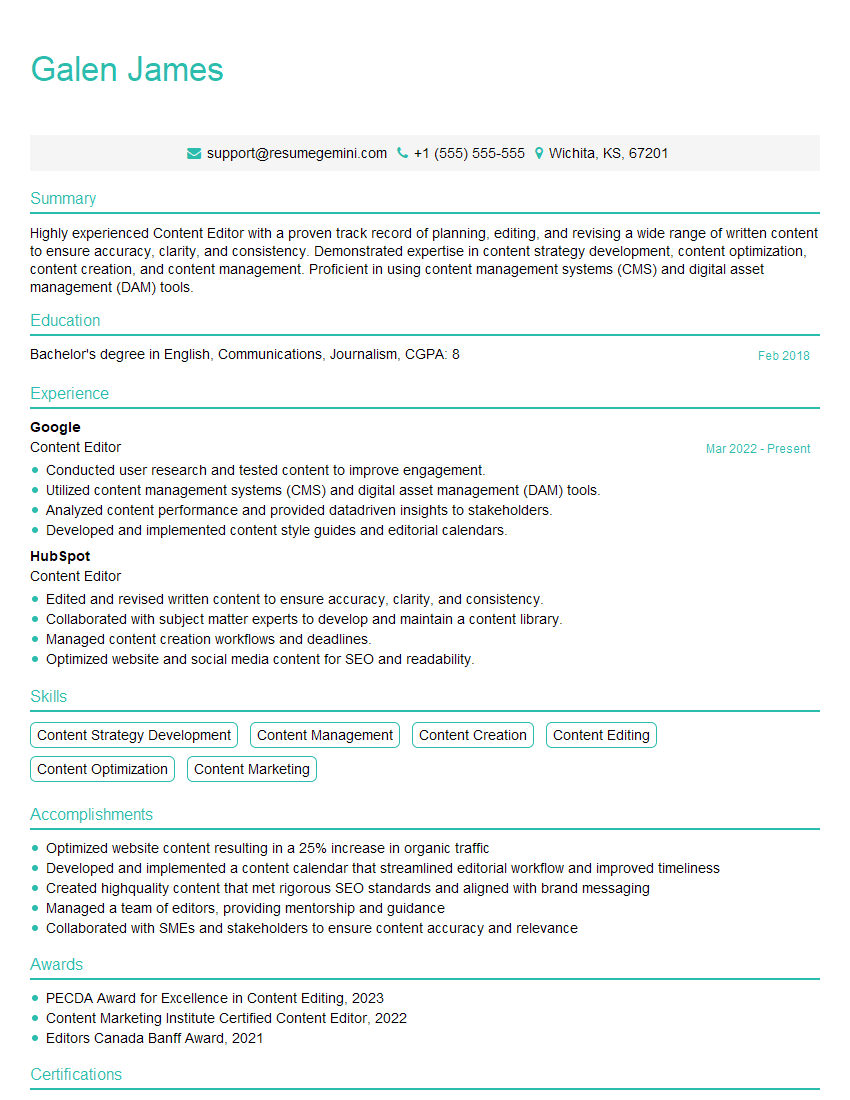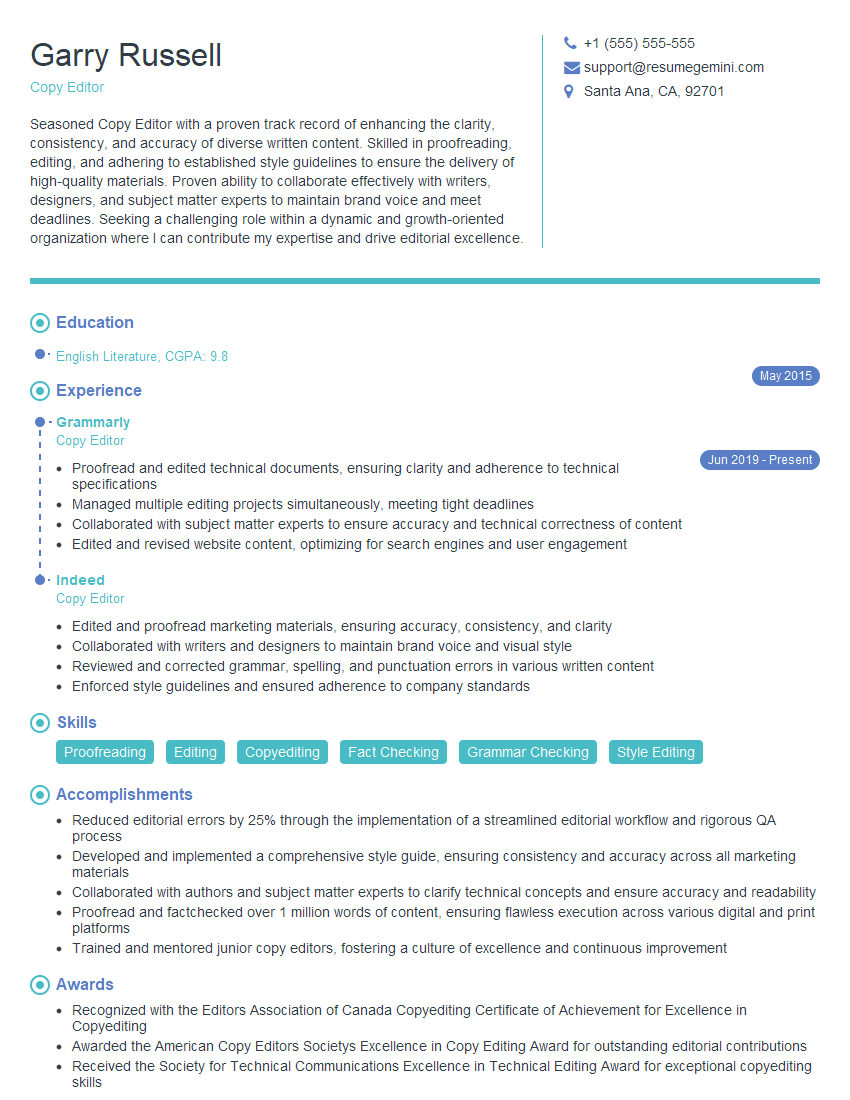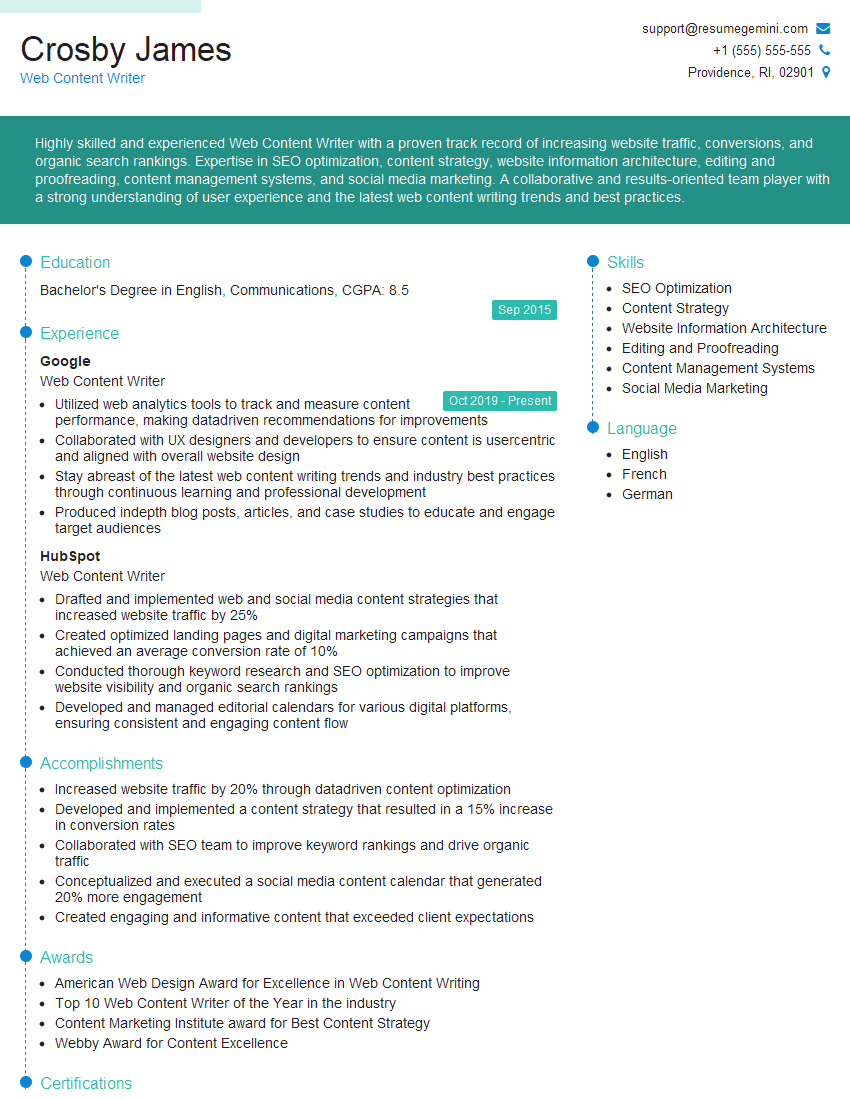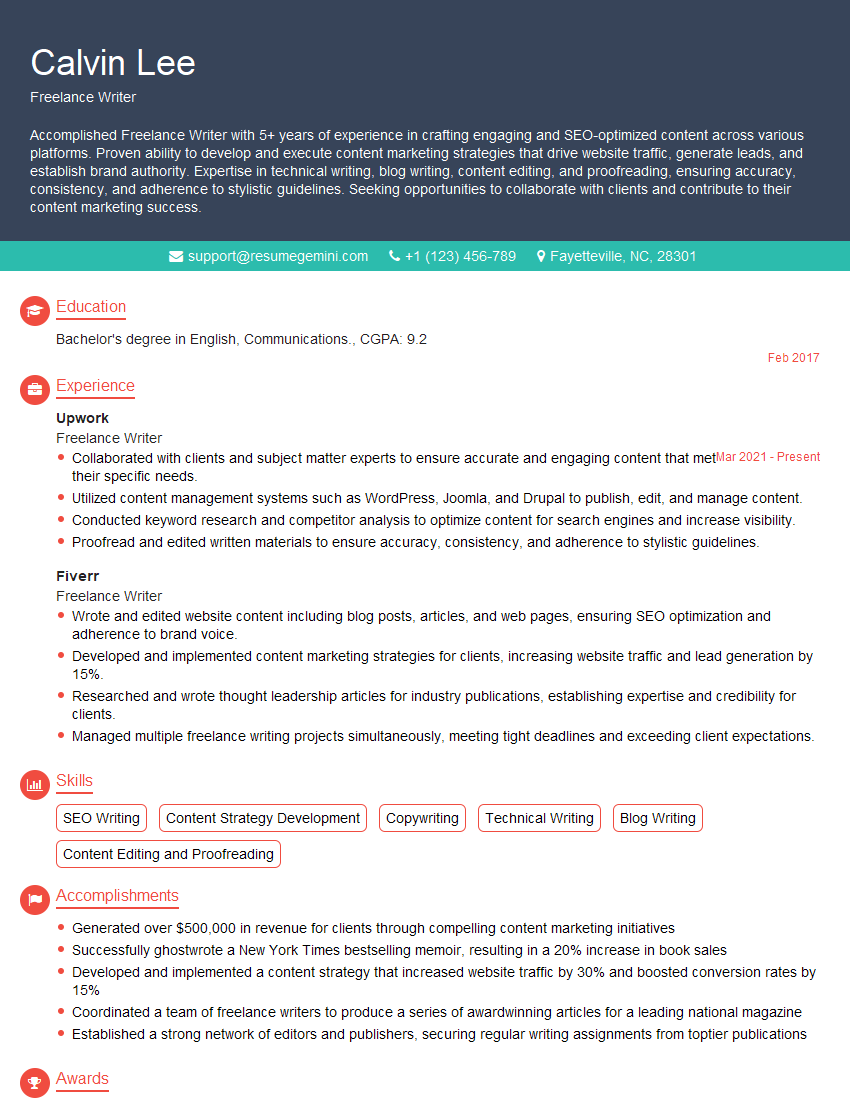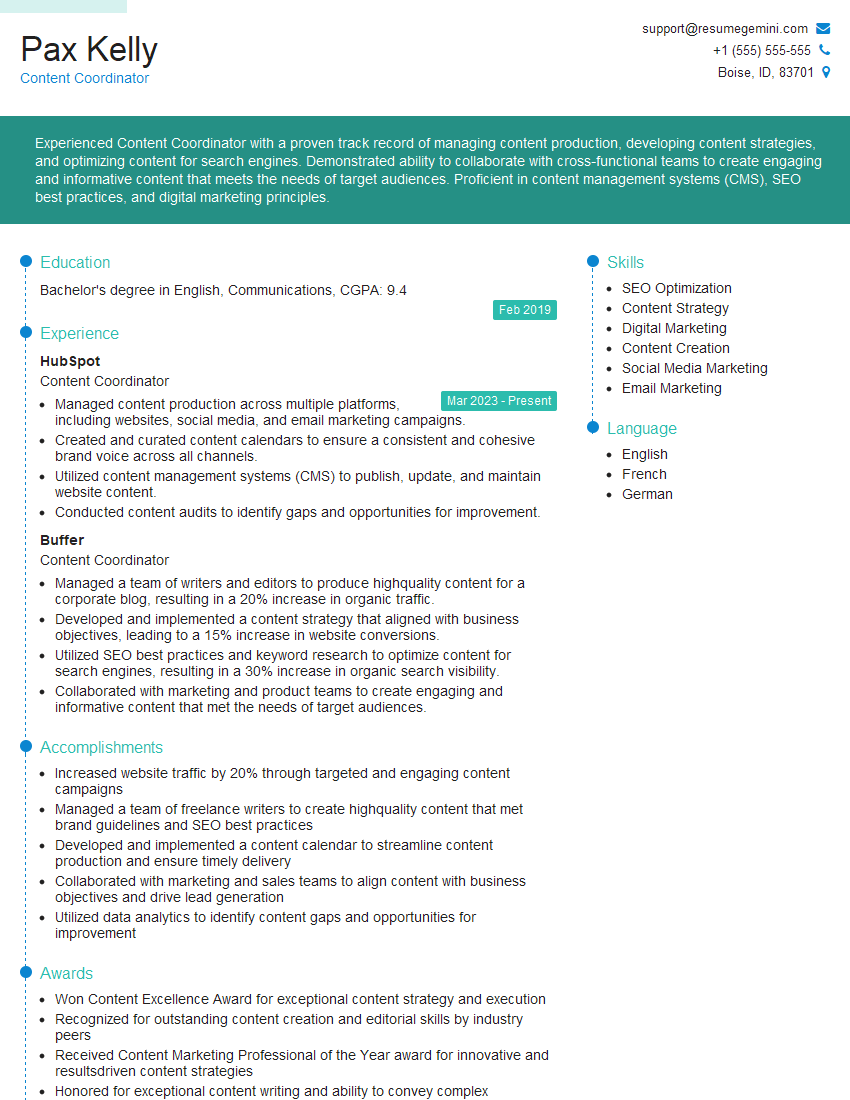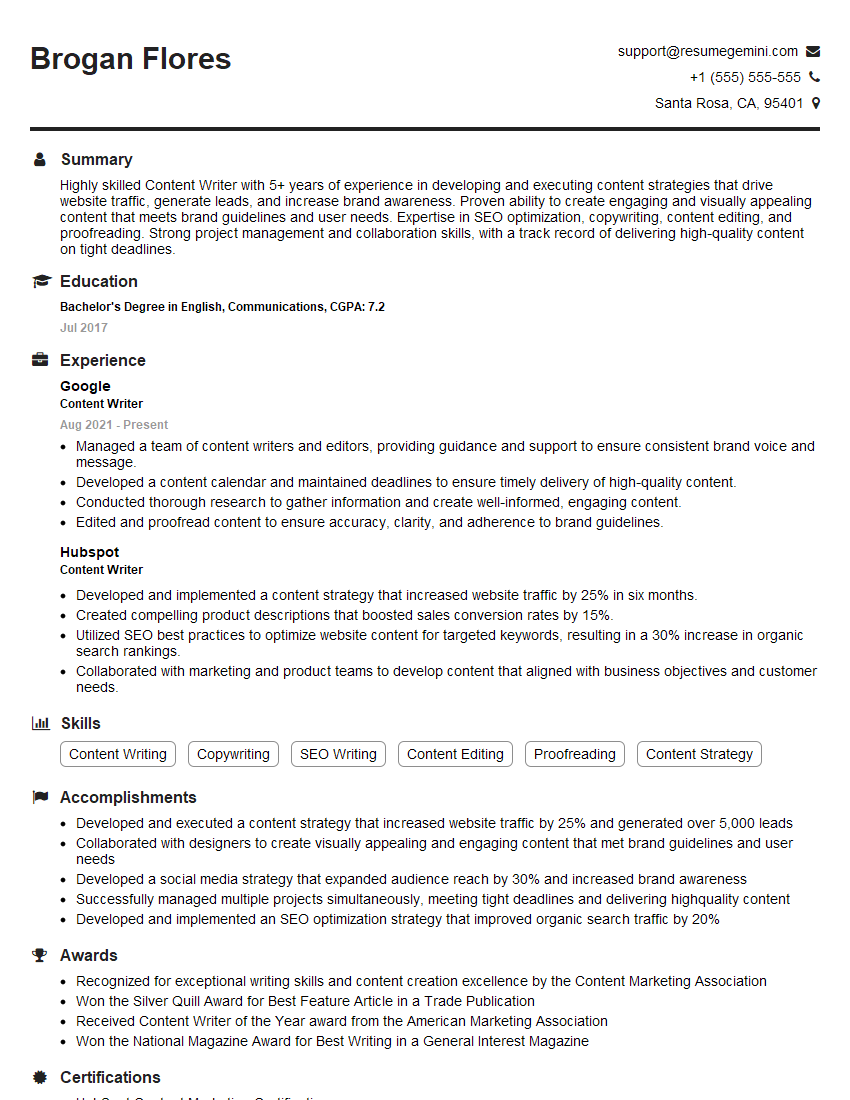Are you ready to stand out in your next interview? Understanding and preparing for Blogging and Content Creation interview questions is a game-changer. In this blog, we’ve compiled key questions and expert advice to help you showcase your skills with confidence and precision. Let’s get started on your journey to acing the interview.
Questions Asked in Blogging and Content Creation Interview
Q 1. Explain your content creation process from ideation to publication.
My content creation process is a structured yet flexible approach ensuring high-quality, engaging content. It begins with ideation, where I brainstorm topics relevant to my target audience and aligned with business goals. This often involves competitor analysis, trend research using tools like Google Trends, and analyzing audience feedback. Next comes research, meticulously gathering information to support the chosen topic. This includes fact-checking, interviewing experts, and using reliable sources. Then, I create a detailed outline, organizing the information logically and ensuring a smooth narrative flow. The writing phase follows, focusing on clarity, conciseness, and engaging storytelling. After writing, I thoroughly edit and proofread, paying close attention to grammar, style, and accuracy. Finally, I optimize the content for SEO, ensuring it’s easily discoverable by search engines. This includes keyword integration, meta descriptions, and image optimization. The last step is publication, which involves scheduling the content and promoting it across various channels.
For example, if I’m writing about ‘sustainable living,’ I’d research current trends, interview eco-conscious individuals, and compile statistics to support my claims. My outline would then structure the content logically, perhaps starting with defining sustainable living, exploring practical tips, and concluding with inspiring success stories.
Q 2. How do you conduct keyword research for blog posts?
Keyword research is the cornerstone of successful blogging. It involves identifying relevant keywords and phrases people use when searching for information online. My process starts with brainstorming potential keywords related to my blog’s niche. Then, I use tools like Ahrefs, SEMrush, or even Google Keyword Planner to analyze search volume, competition, and keyword difficulty. I look for keywords with a good balance of search volume (meaning many people are searching for it) and low competition (meaning it’s not overly saturated). I also consider long-tail keywords—longer, more specific phrases that often have less competition. Once I’ve identified a set of target keywords, I incorporate them naturally within my blog post’s title, headings, body text, and meta descriptions.
For instance, instead of just targeting ‘organic food,’ I might focus on long-tail keywords like ‘best organic grocery stores near me’ or ‘how to start an organic garden in small spaces.’ This allows me to target a more specific audience with higher conversion potential.
Q 3. Describe your experience with SEO best practices.
My experience with SEO best practices is extensive. I understand the importance of on-page and off-page optimization. On-page optimization involves optimizing individual web pages to rank higher and earn more relevant traffic in search engines. This includes optimizing title tags, meta descriptions, header tags (H1-H6), image alt text, and internal linking. Off-page optimization focuses on building the authority and trust of a website through techniques like link building (acquiring backlinks from high-quality websites) and social media promotion. I’m also familiar with technical SEO aspects, such as site speed optimization, mobile-friendliness, and schema markup. I consistently stay updated on Google’s algorithm updates and best practices to ensure my content remains search engine friendly.
For example, I’d use schema markup to help search engines understand the content of my blog posts, potentially leading to rich snippets in search results. I’d also actively build backlinks from reputable sources in my industry to increase my website’s domain authority.
Q 4. What content management systems (CMS) are you familiar with?
I’m proficient in several Content Management Systems (CMS), including WordPress, Wix, and Squarespace. WordPress is my preferred choice due to its flexibility, extensive plugin ecosystem, and large community support. Its ease of use and powerful features make it ideal for creating and managing complex websites and blogs. Wix and Squarespace, while simpler to use, are excellent for users who prefer a more drag-and-drop approach to website building. My familiarity with these different CMS platforms allows me to adapt to various client needs and project requirements.
Q 5. How do you measure the success of a blog post or content campaign?
Measuring the success of a blog post or content campaign involves analyzing various key performance indicators (KPIs). For individual blog posts, I monitor metrics like page views, time on page, bounce rate, and social shares. A low bounce rate (meaning people are staying on the page) and high time on page indicate engagement. High social shares suggest the content is resonating with the audience. For broader content campaigns, I track metrics like overall website traffic, lead generation, conversion rates, and return on investment (ROI). Google Analytics is my primary tool for collecting and analyzing this data. I also consider qualitative feedback from comments, social media interactions, and email engagement.
For example, if a blog post about ‘DIY skincare recipes’ receives a high bounce rate, it might suggest the content isn’t meeting reader expectations. On the other hand, high social shares could indicate successful content marketing and potential for future growth.
Q 6. What are your preferred methods for optimizing content for search engines?
My preferred methods for optimizing content for search engines revolve around a holistic approach that prioritizes user experience and search engine relevance. This starts with thorough keyword research, ensuring the chosen keywords are relevant to the content and have a reasonable search volume. Then, I optimize the on-page elements, including title tags, meta descriptions, header tags, and image alt text, using the target keywords naturally. I also focus on creating high-quality, original, and engaging content that keeps readers interested and encourages them to spend time on the page. Internal linking within the site helps improve navigation and distribute link equity. Finally, I monitor the performance of my content using Google Analytics and adjust my strategy based on the data. This iterative process helps to continuously improve search engine rankings.
Q 7. How do you adapt your writing style to different target audiences?
Adapting my writing style to different target audiences is crucial for effective communication. I start by understanding the audience’s demographics, interests, and level of expertise. For example, writing a blog post about advanced coding for experienced programmers requires a different tone and vocabulary than a blog post about basic coding for beginners. I adjust my language, formality, and the level of detail accordingly. I might use more technical jargon for experts, while employing simpler language and more explanations for beginners. I also consider the preferred communication channels—a blog post will have a different style than a social media update. Thorough audience research ensures my writing resonates with the intended readers, leading to higher engagement and better results.
For instance, when writing for a younger audience, I might use more casual language and incorporate visual elements like GIFs or memes. Conversely, when writing for a professional audience, I’d adopt a more formal tone and focus on providing detailed, factual information.
Q 8. Describe your experience with different content formats (e.g., blog posts, videos, infographics).
My experience spans a wide range of content formats, each with its unique strengths. Blog posts form the core of my work, allowing for in-depth exploration of topics through text, images, and embedded media. I’ve crafted hundreds of blog posts on diverse subjects, from technical guides to personal narratives, always focusing on clear, concise writing and SEO optimization. Videos are another key format. I’ve produced explainer videos, tutorials, and even short documentaries, leveraging video editing software to create engaging visuals that complement the narrative. This includes scripting, filming, editing, and optimizing for different platforms. Infographics, on the other hand, allow for visually compelling communication of complex data or processes. I’ve created numerous infographics, using design tools to transform data into easily digestible visuals that quickly convey key information. Each format demands a different skillset; for instance, strong writing skills are essential for blog posts, while video production necessitates proficiency in filming and editing techniques, and infographic design requires a keen eye for aesthetics and data visualization.
- Blog Posts: I’ve written extensively on SEO best practices, content marketing strategies, and digital trends.
- Videos: I’ve created video tutorials on using specific software tools, and short documentary-style pieces on emerging trends within industries.
- Infographics: I’ve developed infographics detailing complex statistical data and illustrating step-by-step processes.
Q 9. How do you handle writer’s block?
Writer’s block is a common challenge, but I’ve developed strategies to overcome it. My approach is multifaceted. First, I step away from the computer. A walk, a change of scenery, or even a short meditation session can help clear my mind. Second, I brainstorm. I use mind maps, freewriting, or even simply jotting down ideas to spark creativity. Sometimes, simply changing my writing environment helps. If I’m stuck on a specific section, I’ll move on to another part of the piece and come back to it later with fresh eyes. Third, I actively seek inspiration. I read articles, watch videos, or engage in discussions related to my topic. Finally, if all else fails, I don’t hesitate to seek feedback from colleagues or mentors. A fresh perspective can often unlock the creative flow. Think of it like a muscle – the more you use it, the stronger it becomes; consistent writing is key to overcoming writer’s block.
Q 10. How do you ensure the accuracy and factual correctness of your content?
Accuracy and factual correctness are paramount. I employ a rigorous fact-checking process. This starts with meticulous research, using multiple reputable sources to verify information. I cross-reference data from diverse sources, particularly for claims requiring strong evidence. I also cite my sources clearly and transparently, allowing readers to independently verify the information. For complex topics, I may consult with subject matter experts to ensure accuracy. Finally, before publishing, I always perform a thorough review of my work, looking for inconsistencies, inaccuracies, or gaps in information. This multi-step process minimizes the risk of publishing incorrect or misleading information. In essence, I treat accuracy as a non-negotiable aspect of my work.
Q 11. What tools or software do you use for content creation?
My content creation workflow relies on a suite of tools. For writing, I primarily use Google Docs for its collaborative features and ease of use. Grammarly helps with grammar and style checks. For image editing, I use Adobe Photoshop and Canva for creating visually appealing graphics. Video editing is handled with Adobe Premiere Pro and DaVinci Resolve. For infographic design, I utilize Canva and Adobe Illustrator. In addition, I leverage SEO tools like SEMrush and Ahrefs for keyword research and optimization. These tools are integrated into my workflow to enhance efficiency and ensure high-quality output. The choice of tool depends on the specific format and project requirements.
Q 12. How do you manage your time effectively when working on multiple content projects?
Managing multiple projects requires a structured approach. I use project management tools like Trello or Asana to create task lists, set deadlines, and track progress. I break down large projects into smaller, manageable tasks, making them less daunting. I prioritize tasks based on urgency and importance, using methods like the Eisenhower Matrix (urgent/important). Time blocking is essential. I allocate specific time slots for particular tasks, minimizing distractions. Regular review of my schedule allows for adjustments as needed. Furthermore, I strive to maintain a healthy work-life balance, preventing burnout, which significantly impacts productivity. Consistent planning and flexible adaptation are crucial for effective time management in a dynamic environment.
Q 13. Describe your experience with content promotion and distribution strategies.
Content promotion and distribution are as critical as content creation itself. My strategies are multifaceted. I leverage social media platforms like Twitter, LinkedIn, and Facebook to share my content and engage with my audience. I utilize email marketing to reach subscribers directly. Guest posting on relevant blogs expands my reach to a wider audience. I also optimize my content for search engines (SEO) to increase organic visibility. Furthermore, I actively participate in online communities and forums related to my niche. I analyze the performance of my content across different channels, using analytics tools to identify what’s working and what needs improvement. A successful strategy involves continuous testing, refinement, and adaptation based on data-driven insights.
Q 14. How do you stay up-to-date with the latest trends in blogging and content creation?
Staying current in the ever-evolving world of blogging and content creation requires consistent effort. I follow influential bloggers and industry leaders on social media, subscribing to their newsletters and podcasts. I attend webinars and online conferences to learn about the latest trends and best practices. I read industry publications and research reports to stay informed about new technologies and strategies. Moreover, I actively participate in online communities and forums to exchange ideas and learn from other professionals. Continuous learning is not just beneficial, it’s essential for remaining competitive and relevant in this dynamic field. It’s a commitment to ongoing professional development, a constant quest to improve and adapt.
Q 15. How familiar are you with different content marketing strategies?
My familiarity with content marketing strategies is extensive. I’m proficient in various approaches, from inbound marketing focusing on attracting organic traffic through valuable content like blog posts and SEO-optimized articles, to outbound strategies like social media marketing and email campaigns to promote existing content. I also have experience with content pillars and topic clusters to build comprehensive, interconnected content around core themes, improving SEO and user experience. I understand the importance of data analysis – using tools like Google Analytics to track performance, identify areas for improvement, and inform future content strategy. I’m experienced with A/B testing to optimize headlines, calls to action, and overall content performance. My understanding extends to personalization, crafting content tailored to specific audience segments to maximize engagement. For example, I’ve successfully implemented a content strategy for a client focusing on short-form video content on platforms like TikTok and Instagram Reels to reach a younger demographic, while simultaneously creating long-form blog posts for a more in-depth audience.
- Inbound Marketing: Blog posts, SEO, guest blogging.
- Outbound Marketing: Social media, email marketing, paid advertising.
- Content Pillars & Topic Clusters: Creating interconnected content around core themes.
- Data Analysis & A/B Testing: Improving content performance using analytics and experimentation.
- Content Personalization: Tailoring content to specific audience segments.
Career Expert Tips:
- Ace those interviews! Prepare effectively by reviewing the Top 50 Most Common Interview Questions on ResumeGemini.
- Navigate your job search with confidence! Explore a wide range of Career Tips on ResumeGemini. Learn about common challenges and recommendations to overcome them.
- Craft the perfect resume! Master the Art of Resume Writing with ResumeGemini’s guide. Showcase your unique qualifications and achievements effectively.
- Don’t miss out on holiday savings! Build your dream resume with ResumeGemini’s ATS optimized templates.
Q 16. How do you collaborate with designers, developers, or other team members?
Collaboration is key to successful content creation. My approach involves clear communication and proactive engagement. I begin by understanding the designer’s and developer’s perspectives, ensuring everyone is on the same page regarding the project’s goals and aesthetics. For example, I’ll provide designers with detailed briefs outlining the content’s purpose, target audience, and desired tone, including mood boards or style guides when relevant. I work closely with developers to ensure content is optimized for various platforms and devices, from ensuring proper image sizing and alt text for accessibility to confirming smooth integration with CMS (Content Management System) platforms. With other team members, regular check-ins, whether through daily stand-up meetings or weekly progress reviews, help maintain project momentum and address any issues promptly. I utilize project management tools like Asana or Trello for task assignment, progress tracking, and transparent communication.
For instance, when working on a recent infographic project, I collaborated with a designer by providing detailed data and key takeaways, ensuring the visual representation accurately reflected the content’s message. With the developer, I reviewed the embed code to ensure smooth integration into the blog post.
Q 17. How do you prioritize tasks and meet deadlines?
Prioritizing tasks and meeting deadlines requires a structured approach. I typically use a combination of methods, including the Eisenhower Matrix (urgent/important), to categorize tasks and allocate time effectively. I break down large projects into smaller, manageable tasks, setting realistic deadlines for each. I utilize project management tools to track progress and identify potential bottlenecks. Proactive communication with team members about potential delays or challenges is crucial. For instance, if an unexpected delay occurs, I will promptly inform stakeholders and adjust deadlines accordingly. I find that building buffer time into my schedule helps to mitigate unforeseen issues. Regular review of my to-do list and adjustment based on changing priorities is also essential. I’m comfortable working under pressure and prioritizing tasks to deliver high-quality content within deadlines. For example, I once successfully managed to deliver a series of blog posts ahead of schedule, by effectively prioritizing tasks and delegating smaller tasks to team members.
Q 18. Describe your experience with content repurposing and syndication.
Content repurposing and syndication are crucial for maximizing the value of existing content. Repurposing involves transforming a piece of content into a different format, such as turning a blog post into an infographic, a short video, or a series of social media posts. Syndication involves distributing content across multiple platforms to reach a wider audience. I have extensive experience in both. For example, a long-form blog post on SEO best practices could be repurposed into several short social media posts, each highlighting a single key takeaway. The same blog post could be syndicated on other relevant websites or platforms with permission. This strategy not only saves time and resources but also expands reach and engagement. When syndicating, I always ensure proper attribution and comply with copyright regulations. The key is to add value with each repurposing. Simply reposting is less effective than creating something new that is tailored to the new platform and audience. I track the performance of repurposed and syndicated content to understand what resonates best with different audiences and refine my strategy accordingly.
Q 19. How do you deal with negative feedback or criticism on your content?
Negative feedback, while initially challenging, offers invaluable opportunities for growth. My approach involves carefully reviewing the criticism, separating constructive feedback from personal attacks. Constructive criticism is analyzed for valid points. For instance, if feedback indicates a lack of clarity in a certain section, I’ll revise the content to address that. I’ll respond to the commenter or author of the feedback professionally and consider their perspective. If the criticism is unwarranted or abusive, a measured response, if any, is offered. However, learning from every piece of feedback is key. This approach ensures continuous improvement and stronger content creation skills. I maintain professionalism, regardless of the tone of the criticism, focusing on what can be learned and improved. Over time, a thicker skin and more resilience to criticism develops. Each instance is a valuable learning experience.
Q 20. How do you handle editing and proofreading your own work?
Self-editing and proofreading are crucial steps in the content creation process. My approach involves multiple rounds of review. First, I let the content rest for a period of time – usually a day or two – before revisiting it with fresh eyes. This allows me to spot errors I might have missed during the initial writing. I carefully check grammar, spelling, punctuation, and style consistency. I utilize grammar and spell-check tools, but rely primarily on my own careful reading to catch nuanced errors. I often read the content aloud to identify awkward phrasing or sentence structure. I also check for consistency in terminology and tone throughout the piece. Finally, before publication, I have a second pair of eyes review the work to catch any remaining errors. This layered approach helps ensure high-quality, error-free content. I prioritize precision and clarity.
Q 21. Explain your understanding of different content formats and their purposes.
Understanding different content formats and their purposes is essential for effective content marketing. I am proficient in various formats, each serving a unique purpose. For instance, blog posts are ideal for in-depth explanations and thought leadership, while short-form content like social media updates are perfect for quick engagement. Infographics visually communicate data and complex information, while videos are highly engaging and suitable for showcasing products or processes. Case studies demonstrate real-world results, while ebooks offer extensive information and lead generation opportunities. Podcasts allow for informal discussions and expert interviews. The choice of format depends on the target audience, message, and platform. For example, a detailed product explanation would be best suited to a video or an in-depth blog post, while a quick update on a company event might be best delivered via a social media post. I strategically select formats to maximize impact and engagement.
- Blog Posts: In-depth explanations, thought leadership.
- Social Media Updates: Quick engagement, announcements.
- Infographics: Visual communication of data.
- Videos: Showcasing products, processes.
- Case Studies: Demonstrating real-world results.
- Ebooks: Extensive information, lead generation.
- Podcasts: Informal discussions, interviews.
Q 22. Describe your experience using analytics to inform content strategy.
Analytics are the lifeblood of any successful content strategy. I don’t just create content; I analyze its performance to refine future efforts. My process involves several key steps. First, I define clear Key Performance Indicators (KPIs) – these could be things like website traffic, bounce rate, time on page, social shares, or conversion rates. Then, I use tools like Google Analytics, SEMrush, and social media analytics dashboards to track these KPIs.
For example, if I see a high bounce rate on a particular blog post, I’ll analyze the content to understand why. Is it too long? Is the headline misleading? Is the topic not relevant to the target audience? This data-driven analysis helps me understand what’s working and what isn’t, allowing me to iterate and improve.
I also use A/B testing to compare different versions of headlines, calls to action, or even the overall layout of a blog post. This provides concrete evidence of what resonates best with the audience, and allows me to optimize for maximum impact. Ultimately, data-informed decision making leads to a more effective and efficient content strategy.
Q 23. What are your preferred methods for gathering user feedback?
Gathering user feedback is crucial for understanding audience needs and preferences. I employ a multi-pronged approach to ensure a holistic perspective.
- Surveys: I utilize both short, quick polls and more in-depth surveys through platforms like SurveyMonkey or Typeform to gather quantitative and qualitative data. This allows me to assess satisfaction levels, identify areas for improvement, and gauge audience preferences for various content formats.
- Social Media Engagement: Actively monitoring comments, direct messages, and mentions on platforms like Twitter, Facebook, and Instagram provides real-time feedback and insight into what resonates with my audience. Responding to comments and questions demonstrates engagement and encourages further interaction.
- Focus Groups: For more in-depth understanding, I sometimes conduct focus groups or user interviews to delve deeper into specific topics or concerns. This qualitative approach helps to uncover underlying reasons behind user behaviour.
- Website Feedback Forms: Embedding simple feedback forms on my website allows users to easily share their thoughts and suggestions directly. I make sure the forms are easily accessible and the process is straightforward.
By combining these methods, I gain a comprehensive understanding of user needs and preferences, informing content creation and optimization for maximum impact.
Q 24. How do you ensure content aligns with brand guidelines and messaging?
Brand consistency is paramount. Before creating any content, I thoroughly review and understand the brand’s style guide, voice, and messaging. This includes visual elements such as logos and color palettes, as well as written guidelines on tone, language, and terminology. I ensure that every piece of content, from blog posts to social media updates, adheres strictly to these guidelines.
For example, if a brand emphasizes a friendly and approachable tone, I’ll use casual language and avoid jargon. If the brand is known for its professionalism and expertise, I’ll employ a more formal and informative tone. I often use a style guide checklist to ensure consistent application across all content.
I also maintain a central repository of brand assets, such as approved logos and brand colors, making them readily available to the team. This helps maintain consistency across all channels and ensures every piece of content reinforces the brand identity.
Q 25. What experience do you have with creating engaging social media content?
Creating engaging social media content requires a deep understanding of the platform’s nuances and its respective audience. I have extensive experience in developing content across various platforms including Facebook, Instagram, Twitter, LinkedIn, and TikTok.
For instance, on Instagram, I focus on visually appealing content like high-quality images and short, engaging videos, using relevant hashtags to increase visibility. On LinkedIn, my approach leans towards professional and informative updates, sharing industry insights and thought leadership content. For Twitter, I concentrate on concise, impactful messages and engaging with the community through discussions and replies.
My strategy always involves analyzing the platform’s algorithm and audience demographics to tailor content accordingly. I consistently monitor performance metrics such as engagement rate, reach, and click-through rates to optimize my approach and adapt to evolving trends.
Q 26. Describe your process for creating compelling headlines and calls-to-action.
Compelling headlines and calls to action are critical for capturing attention and driving engagement. My process involves a blend of creativity and strategy.
For headlines, I brainstorm multiple options, keeping in mind the target audience and the core message. I often use headline formulas, like the ‘how-to’ formula or the question formula, to structure the headline effectively. I then test different versions using A/B testing to determine which performs best.
When crafting calls to action (CTAs), I make them clear, concise, and benefit-driven. Instead of simply saying ‘Learn More’, I might use something like ‘Download Your Free Guide Now’ or ‘Get Started Today’. The CTA should clearly indicate the next step and provide an incentive for the user to take action. Testing different CTAs is just as important as testing headlines; I frequently A/B test different CTA variations to optimize conversion rates.
Q 27. How do you adapt your content to different platforms (e.g., website, social media, email)?
Adapting content for different platforms is key to maximizing reach and impact. Each platform has its own unique characteristics, audience expectations, and optimal content formats.
- Website: On my website, I typically use long-form blog posts, in-depth articles, and detailed guides. This format allows for comprehensive coverage of topics and in-depth exploration of ideas.
- Social Media: Social media demands concise, easily digestible content. I use shorter posts, compelling visuals, and engaging videos tailored to the specific platform’s audience and algorithm.
- Email: Emails require a more personal and direct approach. I use a conversational tone, clear subject lines, and strong calls to action to drive engagement. Personalization is also key to effective email marketing.
This multi-channel approach ensures that my content resonates with the audience on each platform, maximizing overall reach and engagement.
Q 28. What are your salary expectations for this role?
My salary expectations for this role are dependent on the full scope of responsibilities, company benefits, and overall compensation package. However, based on my experience and skills, I am targeting a salary range of [Insert Salary Range Here]. I am open to discussing this further and aligning my expectations with your budget.
Key Topics to Learn for Blogging and Content Creation Interview
- Content Strategy & Planning: Defining target audiences, setting content goals (SEO, engagement, brand awareness), and developing editorial calendars. Practical application: Creating a content plan for a hypothetical client with specific marketing objectives.
- SEO Optimization: Keyword research, on-page optimization (title tags, meta descriptions, header tags), off-page optimization (link building, social media promotion). Practical application: Analyzing a blog post for SEO weaknesses and suggesting improvements.
- Content Formats & Styles: Mastering various content formats (blog posts, articles, social media updates, infographics, videos) and adapting writing styles to suit different platforms and audiences. Practical application: Explain the strengths and weaknesses of different content formats for a given topic.
- Content Creation Workflow: From ideation and research to writing, editing, proofreading, and publishing. Practical application: Describe your personal workflow and how you manage deadlines and collaborate with others.
- Content Management Systems (CMS): Familiarity with popular CMS platforms like WordPress, understanding of plugin usage and theme customization. Practical application: Discuss the advantages and disadvantages of different CMS platforms.
- Analytics & Reporting: Tracking key metrics (website traffic, engagement, social media reach), analyzing data to measure content performance and make data-driven decisions. Practical application: Explain how you would interpret website analytics to improve content strategy.
- Social Media Marketing: Understanding how to promote content on various social media platforms and engaging with audiences. Practical application: Outline a social media strategy for promoting a new blog post.
- Ethical Considerations: Understanding plagiarism, copyright, and responsible content creation practices. Practical application: Discuss your approach to ensuring ethical and responsible content creation.
Next Steps
Mastering blogging and content creation opens doors to diverse and rewarding career opportunities, offering significant growth potential in marketing, communications, and digital media. To maximize your job prospects, crafting an ATS-friendly resume is crucial. ResumeGemini is a trusted resource that can help you build a professional and impactful resume, ensuring your skills and experience shine through. Examples of resumes tailored to Blogging and Content Creation are available, further enhancing your application process.
Explore more articles
Users Rating of Our Blogs
Share Your Experience
We value your feedback! Please rate our content and share your thoughts (optional).
What Readers Say About Our Blog
Interesting Article, I liked the depth of knowledge you’ve shared.
Helpful, thanks for sharing.
Hi, I represent a social media marketing agency and liked your blog
Hi, I represent an SEO company that specialises in getting you AI citations and higher rankings on Google. I’d like to offer you a 100% free SEO audit for your website. Would you be interested?


